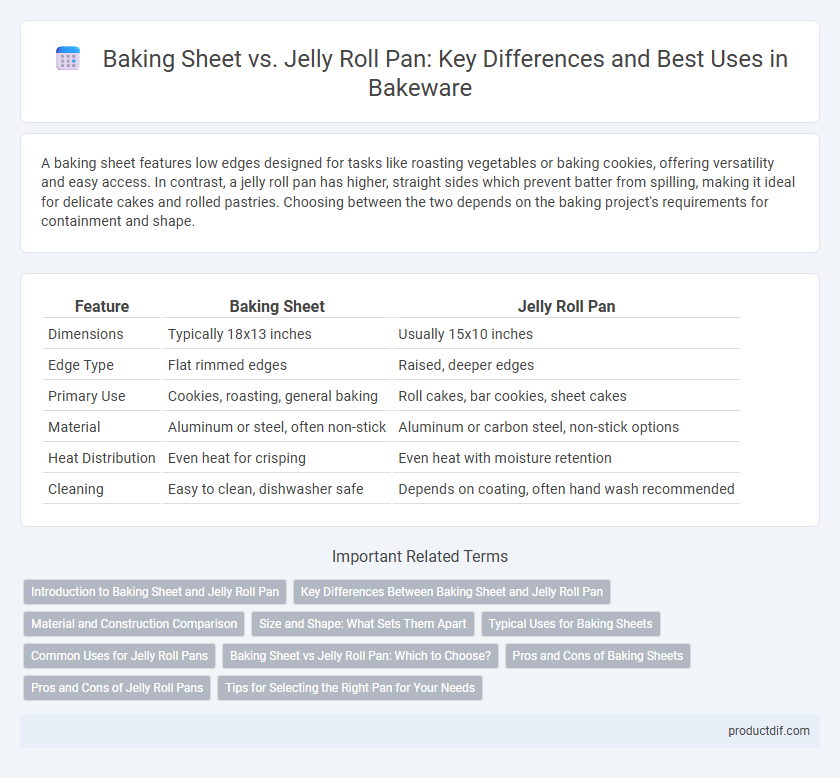A baking sheet features low edges designed for tasks like roasting vegetables or baking cookies, offering versatility and easy access. In contrast, a jelly roll pan has higher, straight sides which prevent batter from spilling, making it ideal for delicate cakes and rolled pastries. Choosing between the two depends on the baking project's requirements for containment and shape.
Table of Comparison
| Feature | Baking Sheet | Jelly Roll Pan |
|---|---|---|
| Dimensions | Typically 18x13 inches | Usually 15x10 inches |
| Edge Type | Flat rimmed edges | Raised, deeper edges |
| Primary Use | Cookies, roasting, general baking | Roll cakes, bar cookies, sheet cakes |
| Material | Aluminum or steel, often non-stick | Aluminum or carbon steel, non-stick options |
| Heat Distribution | Even heat for crisping | Even heat with moisture retention |
| Cleaning | Easy to clean, dishwasher safe | Depends on coating, often hand wash recommended |
Introduction to Baking Sheet and Jelly Roll Pan
A baking sheet is a flat, rectangular metal pan with low edges designed for even heat distribution, ideal for cookies, pastries, and roasting vegetables. A jelly roll pan, similar in shape but with slightly higher edges, prevents batter or juices from spilling, making it perfect for sponge cakes, rolls, and sheet cakes. Both pans are essential bakeware tools, differing mainly in edge height and specific baking applications.
Key Differences Between Baking Sheet and Jelly Roll Pan
Baking sheets are flat, rimmed pans ideal for evenly browning cookies and roasting vegetables, featuring low edges for easy access and airflow. Jelly roll pans have higher, straight sides designed to hold batter securely for cakes and rolled pastries, preventing spills during baking. The primary difference lies in edge height and intended use, with baking sheets offering versatility and jelly roll pans catering specifically to delicate, shaped baked goods.
Material and Construction Comparison
Baking sheets are typically made from aluminum or aluminized steel, providing excellent heat conductivity and even baking surfaces, while jelly roll pans often feature non-stick coatings and reinforced steel for durability and easy release of delicate rolled cakes. The construction of baking sheets includes low sides for versatile use, whereas jelly roll pans have higher edges to contain batter and facilitate rolling. Both types prioritize lightweight and warp-resistant materials, but jelly roll pans emphasize non-stick finishes for precise cake handling.
Size and Shape: What Sets Them Apart
Baking sheets typically feature a large, flat rectangular surface with low or no sides, measuring around 18 by 13 inches, ideal for evenly spreading cookies and roasting vegetables. Jelly roll pans share a similar rectangular shape but have higher sides, usually 1 inch or more, providing extra depth suited for rolled cakes and delicate baked goods. The primary distinction lies in the size and side height, with baking sheets favoring flatness for crisping and jelly roll pans offering containment for batter and liquids.
Typical Uses for Baking Sheets
Baking sheets are ideal for roasting vegetables, baking cookies, and toasting nuts due to their flat surface and raised edges that prevent spills. Their design supports even heat distribution, making them perfect for crispy, golden results. Unlike jelly roll pans, baking sheets typically lack a rim on all sides, which allows for easy slide-off when transferring baked goods.
Common Uses for Jelly Roll Pans
Jelly roll pans, characterized by their shallow sides and flat surface, are commonly used for baking thin cakes like sponge cakes and sheet cakes, as well as roasting vegetables and baking cookies. Their design allows for even heat distribution, making them ideal for delicate baked goods that require quick cooling to maintain texture. Unlike baking sheets, jelly roll pans often accommodate rolling and shaping tasks due to their rimmed edges, enhancing versatility in baking projects.
Baking Sheet vs Jelly Roll Pan: Which to Choose?
Baking sheets and jelly roll pans are essential bakeware pieces, each suited for specific baking tasks. Baking sheets typically feature a flat, rimmed surface ideal for cookies, roasting vegetables, and sheet cakes, while jelly roll pans have higher sides, making them perfect for rolled cakes and bar cookies that require batter containment. Choosing between the two depends on the recipe's need for edge containment versus flat baking surface.
Pros and Cons of Baking Sheets
Baking sheets offer a large, flat surface ideal for evenly baking cookies, roasting vegetables, and making sheet cakes, with edges that prevent spillage and simplify cleanup. Their thin design allows for faster heat conduction, but may result in less structural support, causing delicate items to bend if lifted directly. Compared to jelly roll pans, baking sheets provide more versatility but lack the higher sides needed for recipes requiring deeper containment or liquid batter control.
Pros and Cons of Jelly Roll Pans
Jelly roll pans offer the advantage of shallow sides, promoting even heat distribution and quick baking, ideal for delicate pastries and thin cakes. Their lightweight aluminum construction ensures easy handling, but the shallow depth can limit use for recipes requiring higher sides or liquids. Unlike standard baking sheets, jelly roll pans provide a non-stick surface, reducing the need for additional grease or parchment liners.
Tips for Selecting the Right Pan for Your Needs
Choose a baking sheet with raised edges for versatile use, including roasting and cookies, while a jelly roll pan's shallow sides are ideal for delicate sponge cakes and even heat distribution. Consider material thickness and non-stick coatings to ensure durability and easy release of baked goods. Match pan size to your oven and recipe requirements for optimal baking results and consistent performance.
Baking sheet vs jelly roll pan Infographic

 productdif.com
productdif.com